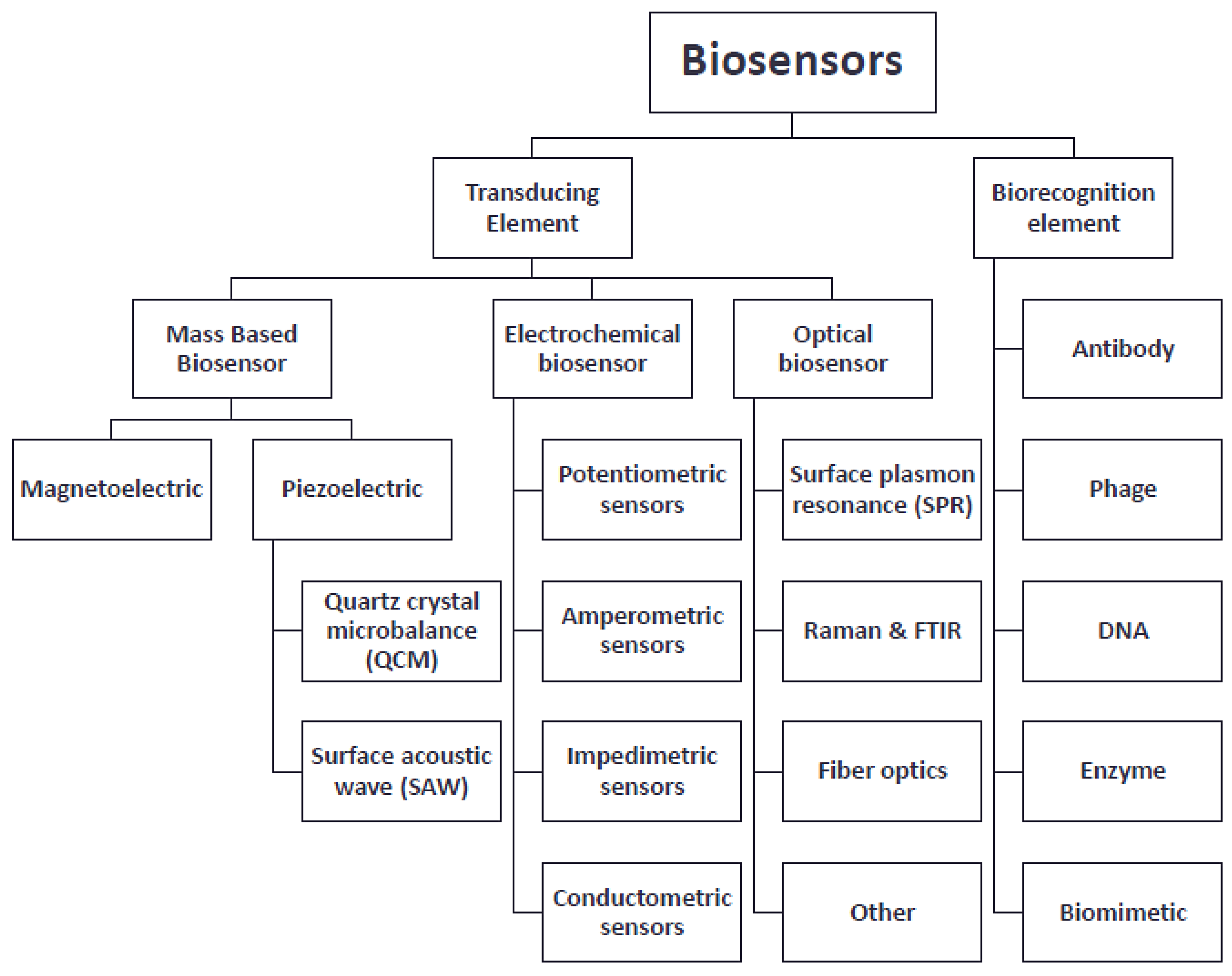Read this article to learn about the features, principle and types of biosensors. A biosensor is an analytical device containing an immobilized biological material (enzyme, antibody, nucleic acid, hormone, organelle or whole cell) which can specifically interact with an analyte and produce physical, chemical or electrical signals that can be measured. Biosensor technology has developed rapidly and can play a key role providing a powerful analytical tool with major applications particularly in medicine. Todays biosensor market is dominated by. ELECTROCHEMICAL BIOSENSORS Modern and future approaches to medical diagnostics James F. of Chemistry, Univ CT, Storrs, Biggest biosensor success story! Other important applications: cancer biomarkers, DNA, peroxide, etc. Biosensors and Their Principles 117 in online control processes for industry or environment, or even in vivo studies [6. The difference between biosensor and. Considers a new generation of sensors for use in industrial processes, which measure the chemical environment directly by means of a biological agent mainly enzymes so far. Various specialists from Europe, the US, and Japan identify the device's place in their disciplines; review the principles of m The principles and applications of nanodiagnosis system for a nanobiosensor A nanobiosensor or a nanobiochip is a sensor that has been improved to perform functions that were not possible with the conventional biosensors and biochips by fusing nanotechnology and This feature is not available right now. Advances in biosensors: Principle, architecture and applications Most of the work that is reported in the literature on optical fibre biosensor applications has employed the optic fibre with other optical methods S. IsaoThe principles and applications of nanodiagnosis system for a nanobiosensor. Quantification of biological or biochemical processes are of utmost importance for medical, biological and biotechnological applications. However, converting the biological information to an easily processed electronic signal is challenging due to the complexity of connecting an electronic device directly to a biological environment. Nutrition Figures, Microbiology, Semester, Engineering, Biotechnology, Engineering, Allergies Chapter Notes, Microbiology, Semester, Engineering, Biotechnology Principles and Applications of Biosensors In this article, the principles and applications of these devices for bioprocess monitoring are considered. Several different types of biosensors are described, many reported biosensor applications (Guilbault, 1984). (General Principles and Applications) Free download as Powerpoint Presentation (. txt) or view presentation slides online. The principles of, and the most typical applications for electrochemical biosensors are described in this review. The relevant systems are divided into three types A biosensor is an analytical device, used for the detection of an analyte, that combines a biological component with a physicochemical detector. The sensitive biological element, e. tissue, microorganisms, organelles, cell receptors, enzymes, antibodies, nucleic acids, etc. , is a biologically derived material or biomimetic component that interacts, binds, or recognizes with the analyte under. (General Principles and Applications) Free download as Powerpoint Presentation (. txt) or view presentation slides online. You find details on the latest cellbased biosensor models and novel microstructure biosensor techniques. Taking an interdisciplinary approach, this unique volume presents the latest innovative applications of cellbased biosensors in a variety of biomedical fields. A Biosensor Should Be Small, of a size appropriate for use. Not nano size to show how clever you are! Manufacturable in large numbers and at low cost Rapid. Result within the timescale of the processdiagnostic test Economical. Low cost of ownership You find details on the latest cellbased biosensor models and novel microstructure biosensor techniques. Taking an interdisciplinary approach, this unique volume presents the latest innovative applications of cellbased biosensors in a variety of biomedical fields. Biosensor (Principles Applications) PPT, IBT, Biotechnology, Engineering, Semester EduRev Biosensor Technology Through converging the expertise and technologies of its two parent companies, OJBio developed a biosensor technology capable of measuring biomarkers on biochips. The Xtalline product range represents the stateoftheart in mobile enabled testing and monitoring. Marja Nissinen, BioPrint project, Oulu University of Applied Sciences Printed electrochemical biosensor principles and applications 1916 First report on immobilization of proteins: adsorption of invertase on activated charcoal 1922 First glass pH electrode 1956 Clark published his definitive paper on the oxygen electrode. 1962 First description of a biosensor: an amperometric enzyme electrodre for glucose (Clark) Arial Arial Black Wingdings Albertus Extra Bold Calibri Times New Roman Tahoma Strati trasparenti 1Strati trasparenti Microsoft Photo Editor 3. 0 Photo Bitmap Image BIOSENSOR Slide 2 Slide 3 Current Definition Components of a Biosensor Slide 6 Slide 7 Slide 8 Slide 9 Slide 10 Biosensor 1. Biosensors Sensor Principles and Architectures. Functional lipid membranes have not yet found as extensive use in biosensor applications Chan D. Immunosensors principles and applications to clinical chemistry. In this review, we introduce the basic principles of different isothermal exponential amplification methods including enzymebased and enzymefree exponential amplification techniques, and further summarize their applications in electrochemical biosensors during the past five years. Nanomedicine 374 15 Biosensors and Nanobiosensors: Design and Applications Ahmed Touhami Physics Astronomy Department, University of Texas at Brownsville 1. Measurement of MetabolitesThe initial impetus for advancing sensor technology came from health care area, where it is now generally recognized that measurements of blood gases, ions and metabolites are often essential and allow a better estimation of the metabolic state of a patient. In intensive care units for example, patients frequently. edu is a platform for academics to share research papers. An enzyme biosensor is an analytical device that combines an enzyme with a transducer to produce a signal proportional to target analyte concentration. This signal can result from a change in proton concentration, release or uptake of gases, such as ammonia or oxygen, light emission, absorption or. Two fundamental operating principles of a biosensor arebiological recognition and sensing. Therefore, a biosensor can be generally dened as a ce that consists deviof two basic components A biosensor is a biological detection system in which a biological component is combined with a transducer to perform measurement of a biochemical quantity. The development of biosensors started with the invention of enzyme electrodes by Leland C. This introductory text covers in detail the technology and applications of biosensors in their many forms. It provides an extensive survey of the basic principles, functions and applications of different categories of biosensors. The presentation is concise, systematic and well illustrated. Biosensor Principles and Applications (Biotechnology and Bioprocessing) [Loic J. FREE shipping on qualifying offers. Considers a new generation of sensors for use in industrial processes, which measure the chemical environment directly by means of a biological agent mainly enzymes so far. Various specialists from Europe A biosensor is an analytical tool consisting of biologically active material used in close conjunction with a device that will convert a biochemical signal into a quantifiable electrical signal. Principles of Chemical and Biological Sensors, vol. 150 (New Analytical Applications of Piezoelectric Crystal Biosensors, Biosensor. A large number of applications in life sciences, including binding kinetics of receptorbiomolecule pairs and virusprotein interactions, are using evanescent wavebased biosensors for their studies. The various types of biosensors such as enzymebased, tissuebased, immunosensors, DNA biosensors, thermal and piezoelectric biosensors have been deliberated here to highlight their indispensable applications in multitudinous fields. Biosensor Principles and Applications CRC Press Book Considers a new generation of sensors for use in industrial processes, which measure the chemical environment directly by means of a biological agent mainly enzymes so far. A biosensor is an analytical device that responds to an analyte in an appropriate sample and interprets its concentration as an electrical signal via a suitable combination of a biological recognition system and an electrochemical transducer. Provides a broad range of information from basic principles to advanced applications of biosensors and nanomaterials in health care diagnostics. Applications in Health Care Diagnostics is an excellent book for researchers, scientists, regulators, 9. 3 Biosensor Applications of QDs 187. One well known example of a clinically applied biosensor is the glucose monitor, which is used on a routine basis by diabetic individuals to check their blood sugar level. Principles of AffinityBased Biosensors Kim R. Rogers government, and commercial sectors to develop affinitybased biosensor products, little obvious success has been realized through commercialization of these devices for specific applications (such as the enzyme Electrochemical biosensors principles and applications Miroslav Pohanka 1, Petr Skldal 2 1 Centre of Advanced Studies, Faculty of Military Hea lth Sciences, University of Defense, Hradec. The Biosensor research has a significant role in the development of modern electronics. This article discusses about different types of Biosensors working and applications. A Biosensor is an analytical device. A final project will be assigned where students research potential applicationsneeds for biosensors, and propose a conceptual design of a suitable sensor to address this need. The term biosensor is short for biological sensor and is a device made up of a transducer and a biological element that may be an enzyme, an antibody, or a nucleic acid. Buy Biosensor Principles and Applications from Dymocks online BookStore. Find latest reader reviews and much more at Dymocks Electrochemical biosensors principles and applications Miroslav Pohanka1, Petr Skldal2 Centre of Advanced Studies, Faculty of Military Health Sciences, University of Defense, Hradec Krlov, Czech Republic 2 Department of Biochemistry and National Center for Biomolecular Research, Masaryk University, Brno, Czech Republic About videoit is part of lecture presented by madhuri Sharma, assistant. at biyani Group College on behalf of guru kpo. This lecture is about biosensor what is biosensor. Biosensors for medical applications provides a comprehensive review of established, cutting edge and future trends in biomedical sensors and their applications. Part one focuses on key principles and transduction approaches, reviewing electrochemical, piezoelectric and nanosized biosensors..











